The AMD Radeon VII Review: An Unexpected Shot At The High-End
by Nate Oh on February 7, 2019 9:00 AM ESTFinal Fantasy XV (DX11)
Upon arriving to PC earlier this, Final Fantasy XV: Windows Edition was given a graphical overhaul as it was ported over from console, fruits of their successful partnership with NVIDIA, with hardly any hint of the troubles during Final Fantasy XV's original production and development.
In preparation for the launch, Square Enix opted to release a standalone benchmark that they have since updated. Using the Final Fantasy XV standalone benchmark gives us a lengthy standardized sequence to utilize OCAT. Upon release, the standalone benchmark received criticism for performance issues and general bugginess, as well as confusing graphical presets and performance measurement by 'score'. In its original iteration, the graphical settings could not be adjusted, leaving the user to the presets that were tied to resolution and hidden settings such as GameWorks features.
Since then, Square Enix has patched the benchmark with custom graphics settings and bugfixes to be more accurate in profiling in-game performance and graphical options, though leaving the 'score' measurement. For our testing, we enable or adjust settings to the highest except for NVIDIA-specific features and 'Model LOD', the latter of which is left at standard. Final Fantasy XV also supports HDR, and it will support DLSS at some later date.
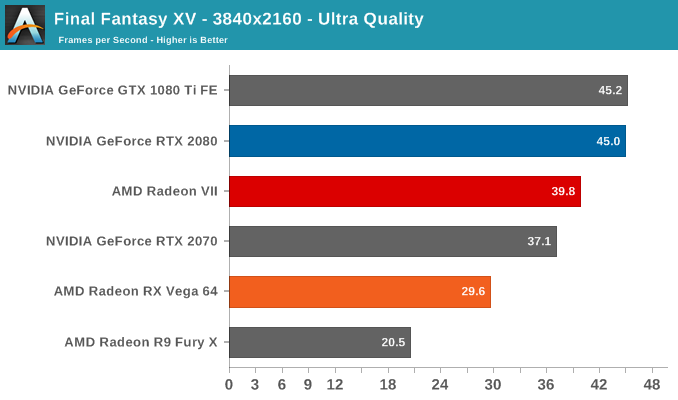
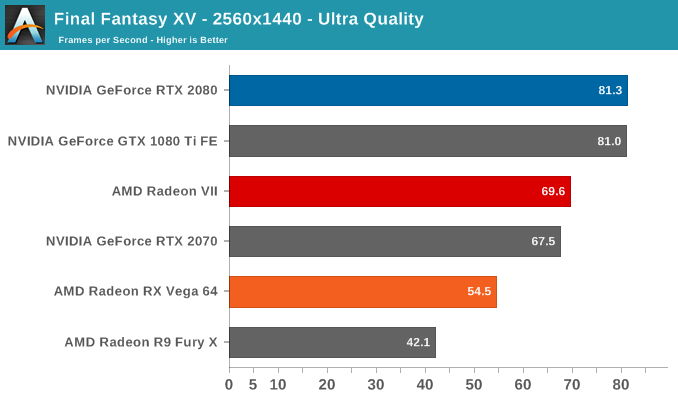
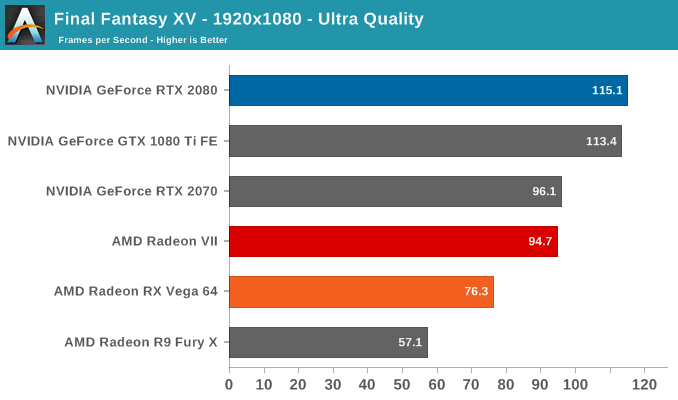
Moving on to Final Fantasy XV, the Radeon VII's showing here is one of the least ideal scenarios. The game has historically performed well on NVIDIA hardware, so the RTX and GTX performance levels are well-known. With a lot of ground to cover from RX Vega 64's starting point, the Radeon VII does well in pushing up to a 34% speedup at 4K and 28% at 1440p. While that is enough to overtake the reference RTX 2070 at 4K/1440p, the RTX 2080 and GTX 1080 Ti FE remain out of reach.
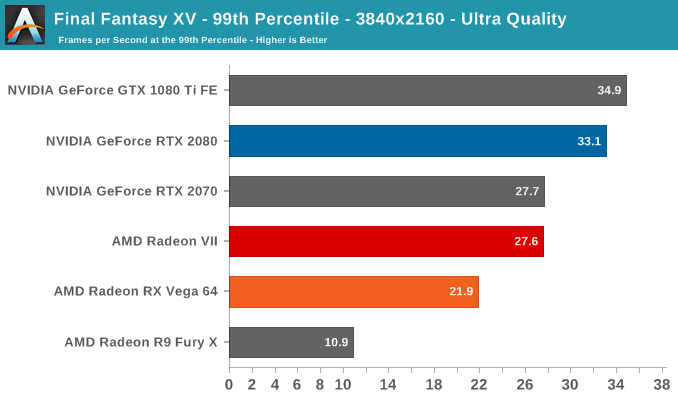
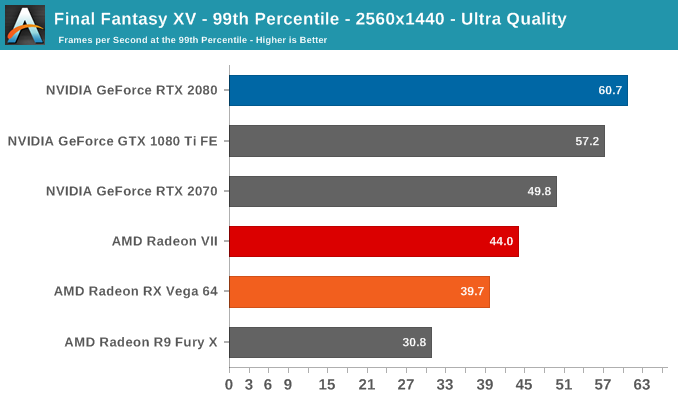
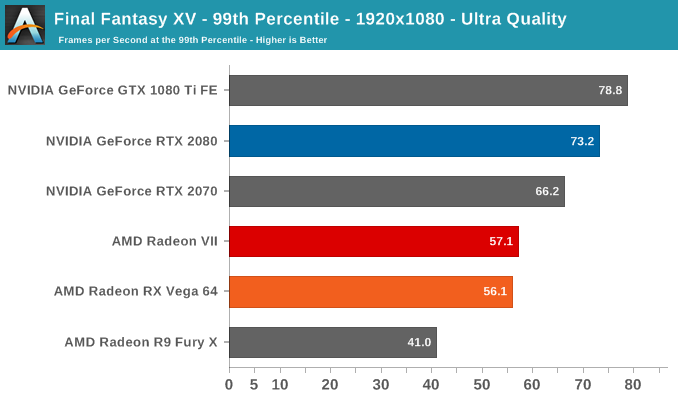











289 Comments
View All Comments
29a - Thursday, February 7, 2019 - link
As usual in these garbage articles the prices given are nowhere near reality. The Vega 64 is $100 cheaper than what is listed.RSAUser - Thursday, February 7, 2019 - link
Anandtech doesn't ever seem to update reviews or prices.They'll compare a device from their history even if there have been months of driver updates that fixed performance issues, so they'll be using non-current info and everyone will assume it's current.
Ryan Smith - Thursday, February 7, 2019 - link
"Anandtech doesn't ever seem to update reviews or prices."On the contrary, quite a bit was updated for this review. Though as driver performance has been rather stable as of late, performance hasn't exactly gone anywhere for most cards on most games.
If you see anything that seems wrong, please let us know. But we go out of our way to try to avoid using any card/driver combinations that result in performance issues.
Korguz - Thursday, February 7, 2019 - link
29aif you think AT does nothing but garbage articles.. then, lets see YOU do better...
as for prices.. meh.. thats something hard to account for as there are things called exchange rates, and other variables that no one can predict.....
Phil85 - Thursday, February 7, 2019 - link
So when will prices of GPU's decrease? Is this the new normal?eva02langley - Thursday, February 7, 2019 - link
Navi should bring value back to mid-range.It is still a nice card for professional/compute/rendering. But for gaming, the price is maybe 50$ too expensive, and AMD really needs to get some better quality fans.
TEAMSWITCHER - Thursday, February 7, 2019 - link
If Navi is missing next generation features like ray tracing and tensor cores, there will be ZERO value to it.eva02langley - Thursday, February 7, 2019 - link
AHAHAHAHA... Ray Tracing... you know the real problem of Ray Tracing? It was never on the table until Jensen brainwashed shill that it was important. by defending it, you obviously prove that you have no critical judgement.By the way, the problem with RT/DLSS is that it will never be implemented because AMD owns consoles, and that devs develop on consoles. There is no monetary benefit to implement gimmick proprietary gameworks features for 1% of the PC user base, unless if Nvidia is paying you to do so.
It will never be a thing for the upcoming console generation. See you in 7 years, where it might be remotely relevant to the industry. As of now, unless you are rendering a CGI movie, it is worthless.
Dribble - Thursday, February 7, 2019 - link
Both the next gen consoles are going to have ray tracing. Microsoft - who wrote and own the spec for the DX12 ray tracing extension currently used by PC's and hence a strong backer of ray tracing - will make one of them.eva02langley - Thursday, February 7, 2019 - link
Not going to happen because RTX is proprietary, it is a closed environment, and require hardware acceleration that AMD is not going to pursue in the short time. Nvidia shoot themselves in the foot by pushing it. Open source is the only way a new standard can be adopted. The whole G-synch fiasco should have been enough to prove it.Hardware could run it still, but the impact on performances is just to important. At that point, developers like Sony have incredible talent in creating new effect that look way more realistic.
Just looking at The Last of Us Part 2 is a good example.